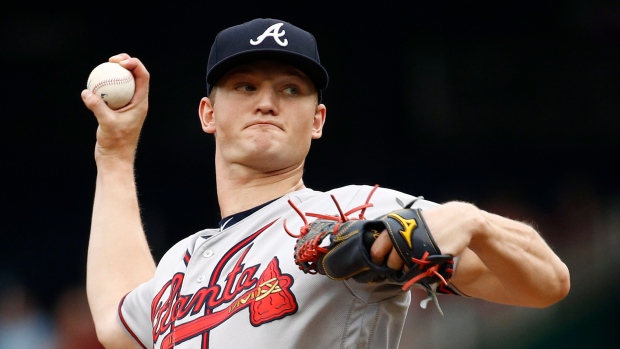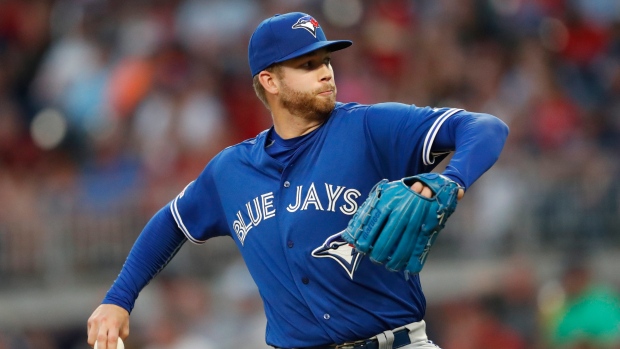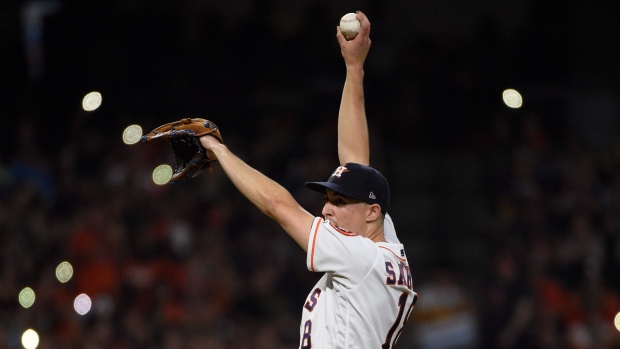Sep 6, 2019
Canada’s Soroka in mix for NL Cy Young Award
The late-season struggles of Los Angeles Dodgers starting pitcher Hyun-Jin Ryu have opened the door for Atlanta Braves rookie starter Mike Soroka to have a genuine shot at winning the NL Cy Young Award, Steve Phillips writes.

Los Angeles Dodgers starting pitcher Hyun-Jin Ryu had a remarkable start to his season. He was selected to start the All-Star Game on behalf of the National League because of his great first half of the 2019 campaign. After his start on Aug. 11, his record stood at 12-2 with a 1.45 ERA. He was having a historic season and was in the mix for the NL Cy Young Award.
But the 32-year-old was also on pace to pitch the most innings he has thrown since 2014. Throughout his career, Ryu has been hampered by numerous injuries and has undergone several surgeries on his shoulder and elbow. He has torn his groin muscle in the past as well.
The fatigue factor seemed likely to take a toll on the Dodgers ace. And, in fact, it has. In his last four starts, Ryu has allowed 21 earned runs and his ERA has jumped to 2.45.
His struggles have opened the door for others in the NL Cy Young race. Certainly, former winners Max Scherzer (9-5, 2.60 ERA) and Jacob deGrom (8-8, 2.76 ERA) are candidates to take home more hardware, and Atlanta Braves rookie starter Mike Soroka (11-3, 2.53 ERA) has a real shot, too.
Soroka, 22, was a first-round pick for the Braves in 2015 out of Bishop Carroll High School in Calgary. He has worked his way through the Braves’ farm system and has emerged as a top-flight starter for a legitimate World Series contender.
Soroka does it differently than Scherzer (12.5 K/9) and deGrom (11.3 K/9), who can overpower good hitters. They are strikeout machines. The young Braves hurler (7.0 K/9) is much more like Ryu (7.91 K/9), who doesn’t strike out hitters at nearly the same rate as others. Both Ryu and Soroka are groundball machines. Like Ryu, Soroka induces bad contact. Everything he throws has movement on it, which makes it very difficult for hitters to centre the ball on the bat.
The tremendous sinking action on Soroka’s fastball keeps the ball in the park because hitters can’t get under it with launch angle and create the backspin necessary to lift it out of the park. His 0.6 HR/9 ratio is the best in the majors.
At this point, Soroka has a legitimate shot at the Cy Young. But he’s going to have to pitch his best when he is at his most fatigued. He has thrown 152.2 innings so far this season and is one inning away from the most he has thrown in a season. He has four or five starts remaining in the regular season, two of which will be against the Washington Nationals and one each against the Philadelphia Phillies and Kansas City Royals.
The Braves will have to decide where he slots in as part of their postseason rotation and whether they want to pitch him in the final season series against the New York Mets. At least one of his starts against the Nationals could line up in a head-to-head matchup with Scherzer, which could go a long way to separating the two of them in the Cy Young race.
One thing for certain, the Braves have found an ace for years to come. If Soroka doesn’t win the Cy Young Award this season, he will have plenty more chances.
Zeuch will fill Jays’ rotation need

The Toronto Blue Jays and their fans got another look at a young pitcher this week when T.J. Zeuch was called up as team rosters expanded Sept. 1.
The 24-year-old lanky right-hander is a former first-round pick of the Jays in 2016. Despite his 6-foot-7 presence that looks imposing, he is not a flame thrower or strikeout pitcher. Zeuch’s fastball averages about 92 mph. His sinker is high quality as he has induced 2.19 groundouts for every fly out. The big question for him is whether his secondary pitches will be good enough to keep hitters off of his fastball.
He threw four innings on Tuesday against the Braves in relief of the opener, Wilmer Font. Zeuch allowed three hits and walked two while punching out four batters. He did allow a couple of runs when he hung a slider to former Blue Jay Josh Donaldson who ripped a two-run double into the left field corner.
My impression of Zeuch is that he’s likely a swing man moving between the fifth starter role and middle relief. He could be a reliever who comes in with men on base trying to induce a double play and then throws a couple more innings. He could be the pitcher who comes in to hold a deficit in the game and allows the offence to come back and win in the later innings. Every good team has that reliever who ends up with seven or eight wins, serving in that role.
He could also serve as a connector who comes in after the opener and works through the lineup twice before turning it over to the late-inning relievers, like he did against the Braves.
Sanchez unlikely in Astros future plans

On Thursday, the Houston Astros announced that former Blue Jay Aaron Sanchez was done for the season and will undergo surgery next week on his right pitching shoulder. It is unclear how significant the injury is, but it’s clear that he is likely a non-tender candidate this winter. The Astros will not likely extend him a contract and take the risk of going to arbitration.
Sanchez was traded with reliever Joe Biagini to Houston for outfielder Derek Fisher. Biagini has not fared all that well with Houston after the trade. The league is hitting .341 against him as a member of the Astros.
Likewise, Fisher has not been very good for Toronto (.185/.284/.446). Many Jays fans were disappointed in the trade because they liked Sanchez for the pitcher he once was. The reality is that the trade, at least so far, has been a bust for both parties.
SPITTING SEEDS
- One of the challenges of interleague play is that American League players are not always familiar with stadiums in the National League. Ditto for NL players playing in stadiums of AL teams.
For example, in Tuesday night’s game between the Astros and Brewers at Miller Park in Milwaukee, Astros outfielder George Springer made a leaping catch in deep centre field. After the catch, he seemed to lose his balance as he braced to hit the wall with his back. But he misjudged where he was on the warning track and fell backwards hitting his head on the padded wall. It was a great catch by Springer and amazing that he was able to hold onto the ball as he fell to the ground. He was dazed after his head hit the wall and stayed down on the ground for several minutes before being carted off the field. The Astros are monitoring him per the concussion protocol and have him listed as day-to-day.
- It’s time for baseball to standardize warning tracks in major league baseball. The tracks are there to alert outfielders that they are in close proximity to the wall. The problem is that warning track widths vary from stadium to stadium. In most outfields, the warning tracks are considered three-step tracks. That means outfielders know once they hit the track they have three steps before they hit the wall. The stadium in Milwaukee, however, has a five-step warning track. Springer is not very familiar with the outfield in Milwaukee because the Astros are an NL club. When he went up for the catch, he thought he was closer to the wall and thought he would back into it. Instead, he fell backwards and hurt himself.
There is a simple solution. Just as the mound is 60 feet, six inches away from home plate and the distance between bases is set at 90 feet in all MLB stadiums, all warning tracks should be exactly the same in every ballpark. It’s a matter of safety. No one is saying teams have to standardize the outfield dimensions of the outfield walls, just the warning track.
-This season, teams that had a six-run lead in the ninth inning were a perfect 274-0 before the Mets-Nationals game on Tuesday night. The Mets had never lost a game in the history of their franchise (806-0) when leading by six or more runs in the ninth – until Tuesday. The Nationals overcame a 10-4 deficit by scoring seven runs in the ninth inning off of three Mets relievers in one of the most dramatic comebacks ever. The Mets had scored five runs in the top of the ninth to increase their lead from 5-4 to 10-4.
But it all unraveled for New York in the bottom of the inning as they all but ended their postseason chances. The Kurt Suzuki walk-off, three-run homer dropped them to five games behind the Chicago Cubs for the second NL wild-card spot. The Mets only have 23 games remaining and there are five teams in front them in the wild-card race. The clock is ticking and the mountain to climb is getting more difficult. It sure feels like they are done.
Credit the Nationals for their never-say-die attitude as they fought back. But also credit the Mets for bouncing back on Wednesday to beat Washington 8-4. You find out a lot more about people when things go wrong as opposed to when they go right. Both clubs showed what they are made of by their respective performances. Sometimes a loss is more than a loss and there is no doubt that Tuesday’s devastating turn of events took a pound of flesh out of the Mets.
-You’re probably familiar with Shohei Ohtani, the talented two-way player for the Los Angeles Angels. Ohtnai has the stuff to be an ace pitcher and the athleticism to be an impactful hitter as a DH for LA. He’s recovering from Tommy John surgery but should be back on the mound in 2020 and showing off all of his skills.
You may not be familiar with Michael Lorenzen, the Cincinnati Reds’ own two-way player. On Wednesday night, Lorenzen became the second player in major league history to win the game, homer in the game and play in the field. The other player to accomplish the feat was Babe Ruth.
Lorenzen is a tremendous athlete. He can pitch, hit and play centre field. He isn’t Babe Ruth nor is he Shohei Ohtani, but he is a very valuable weapon. The Reds are an improving organization which is growing in analytical development. It will be interesting to see what creative ways they can use Lorenzen moving forward. He is a reliever and not a starter but his abilities allow the Reds to use him as an opener or at just about any point in the game.
-The New York Yankees are in an enviable position. They’re currently running away with first place in the AL East and currently have the best record (92-49) in all of baseball which would ensure them home field advantage throughout the playoffs. Plus, they expect a number of players to be activated from the injured list in the next couple of weeks including outfielder and former NL MVP Giancarlo Stanton. Luis Severino, their ace from last season, relief pitcher Dellin Betances, who throws pitches in the 98-100 mph range, and third baseman Gio Urshela, who was enjoying a breakout season for the Bronx Bombers, are also in line to return from injury.
The reality is that even if the Yankees don’t get any of the above-mentioned players back from the IL, they still have a legitimate chance to win the World Series. They don’t desperately need any of them. Yankees manager Aaron Boone will have to figure out playing time and roles over the last couple weeks of the season so he can best prepare his players for the post-season. He will have an impossible time fitting all of his good players into the lineup.
-The Los Angeles Dodgers have the best record in the National League (92-50). They have played in the last two World Series and are the favourite to represent the NL again this season. The Dodgers have scored the most runs in the NL and allowed the fewest in 2019. They have the best ERA in the league and have hit the most home runs (an NL record 250 homers). Although so much has gone right for them this season, they have two major problems that could cause them to fall short once again in October: Their ace pitcher, Hyun-Jin Ryu, is struggling miserably (as mentioned at the beginning of this column) and Kenley Jansen, their closer, has a 5.29 ERA since the All-Star break and has blown four of nine save opportunities since then.
The margin for error in a short postseason series is minimal and pitching is critical. Having the ace of the staff and the closer ineffective is a formula for elimination. Keep an eye on those two key pitchers over the next few weeks because if they don’t get it right, L.A. may waste yet another great opportunity to win it all.
-The more I watch games, the more convinced I am that we desperately need an automated strike zone because it will add much more offence to the game. Catchers steal so many strikes on pitches that are off the plate. Pitchers are able to get hitters out without throwing the ball over the plate. Umpires make far more mistakes by calling strikes on pitches that are off the plate than they do by calling balls on pitches over the plate.
Once pitchers realize that they actually have to throw the ball over the plate to get hitters out, it will result in better hitters counts for batters and better pitches to hit. Offence will go up and strikeouts will go down. There will be more contact and more action. The pace of play will improve, too.

